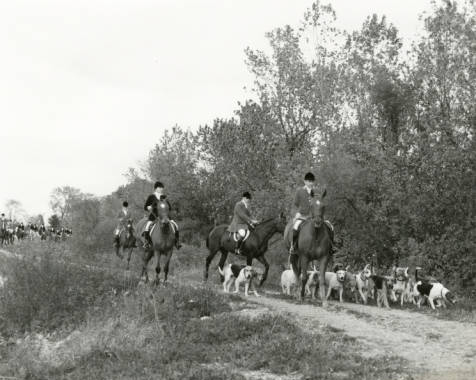
Photo: On the Trail. They met at the home of Russell Fortune’s grandfather with other equine enthusiasts. George Bailey was appointed Master of Foxhounds, and Nate Davis and Wells Hampton were Whips. (Whips help control the hounds.) Hampton and Davis were appointed to ask farmers in the area for permission to ride through their land. The key to any hunt is a right of way over hill and dale. Trying to sell the idea to people who had never heard of a hunt took some time and patience. Circa 1950. Courtesy of the Indiana Historical Society.The Traders Point Hunt (TPH), a nationally recognized fox hunting club, was first conceptualized in 1930. Fox hunting was a sport steeped with European tradition and enjoyed by such colonial figures as George Washington and Thomas Jefferson. In the 1930’s, Traders Point Hunt became an organization of attraction among Indianapolis’s business and professional men and women.
Several local residents who had fox hunted in Virginia had become quite interested in the sport of riding horses to hounds as the hounds chased local vermin. The vermin, or quarry as it is referred to in fox hunting, might include fox, possum, coyote, or racoon, to name a few.
A series of chases on horseback were organized in the fall of 1930. These chases became known as the Ruckfortwich Hunt. Those participating were so enamored with the thrill of riding one’s horse at speed through the woods, over hill and dale, following hounds in full cry, that in February of 1931, Russell Fortune, Jr., Nate Davis, C. O. Alig, Thomas Ruckelshaus, and Wells Hampton discussed the possibility of organizing a drag fox hunt.
A drag hunt relies on a scent, often made of animal urine, laid for hounds to track, with riders on horseback to follow. The interested Indianapolis men and women then informally met for the first time on November 14, 1931, at a red barn on Moore Road, on the outskirts of Marion County where land and woods were plentiful.
Despite the sophistication of riders, the first hunts were not entirely elegant. The scent was laid by a live coon hound led on a chain. A pack of eight coon hounds followed the scent under the direction and encouragement of the huntsman, Raymond Hollingsworth. Riders mounted on horseback then followed in pursuit, all for the thrill of the ride.
The territory, known as Traders Point, was at that time hills and valleys along Eagle Creek from 56th Street to 96th Street, with the Bowman Elder farm and stable as the center of the territory. Those early participants sought barns in this area to stable their horses, making it convenient to ride to the meet (the site where the hunt would gather to begin the chase). Another barn that was popular for stabling hunt horses was located south of Eagle Creek, on the west side of Lafayette Road.
In the spring of 1932, those that enjoyed the early informal drag hunts gathered to discuss organizing a fox hunt that would meet the rules and standards of the credentialing national organization, the Masters of Foxhounds Association of America (MFHA) by establishing field officers, hunt staff that included a Master of Foxhounds, a huntsman, a secretary, whippers-in, hunt membership, and kennels with a pack of English foxhounds. Naming themselves The Traders Point Hunt, TPH was then officially recognized by the MFHA on September 14, 1934.
As a recognized hunt, a hunt logo and colors were adopted and registered with the MFHA. The TPH logo is a burgundy circle, with robin’s egg blue trim and TPH letters, and contained a horn and whip in the center. TPH colors, burgundy and robin’s egg blue, are awarded by the Masters to full status members who have demonstrated great support of the hunt. Colors are proudly worn on the hunt coat collar and sleeves. Members with colors also adopted the tradition of adding buttons with the TPH logo to their hunt coat.
Traders Point Hunt flourished, enjoying the sport of hunting every Wednesday, Sunday, and holidays. In addition to the weekly hunts, TPH activities included an annual holiday hunt ball at such locations as the Indianapolis Athletic Club, the Highland Country Club, and Woodstock; the Cropper’s party, celebrating the season and riders that had fallen off their horse while hunting; the Blessing of the Hounds ceremony; hunter trials; special holiday parties; and many other social gatherings.
The Blessing of the Hounds marked the opening of the formal hunt season, a tradition when riders received a St. Hubert’s medal bestowing a blessing for a safe hunting. Over the years this ceremony was held at such locations as the Salem Methodist Church on Kissel Road, and then moving to the TPH hunt house after it was built in 1966, located at 7240 Hunt Club Road. The kennels for the hounds were located just north of the hunt house on Hunt Club Road, at Wild Air Farm. There are many notable names, too many to list, that enriched the history of TPH.
For decades, TPH members were voracious in their appetite for the sport. Territory for hunting was plentiful as many landowners were very receptive to the hunt riding over their land. Then about 2000, urban sprawl ignited, other non-equestrian options for socialization and sport greatly increased, and TPH experienced a decline in membership. In August of 2018, Traders Point Hunt, the last recognized fox hunting club in existence in Indiana, was no longer financially sustainable and officially closed after 84 years as a nationally recognized fox hunt.
The last Masters of Foxhounds for TPH were Mrs. Elizabeth Johnson, Mrs. Susan McIlwain, and Mr. Tom Santelli. TPH is now registered as an inactive hunt with the MFHA. We give gratitude to the founders and may Traders Point Hunt forever be remembered in the history of Indianapolis.
Susan K. McIlwain, Jt. MFH
Traders Point Hunt
June 5, 2020

